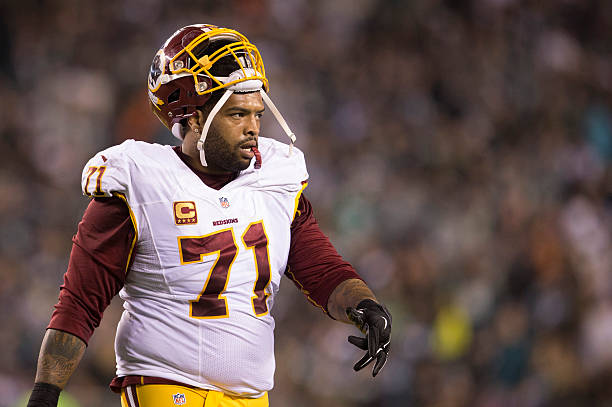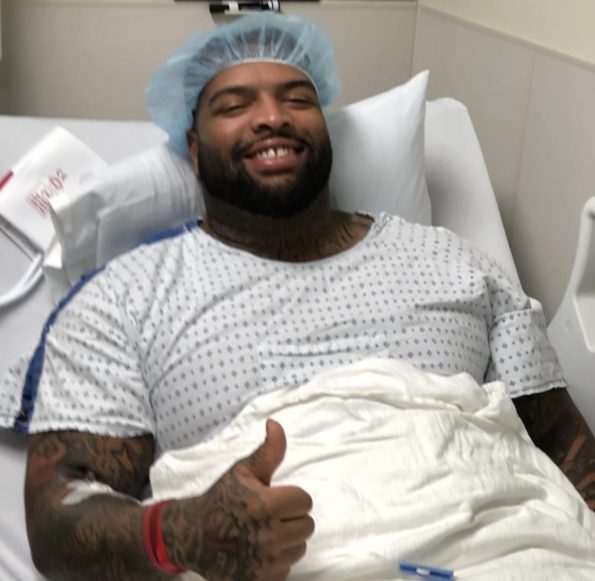
Trent Williams, offensive tackle for the San Francisco 49ers, puts his all into the sport of football. With nine pro-bowl selections under his belt, Williams has played the game of football with the strength, physical and technical dominance that makes opponents question how he does it. What Williams didn’t know, however, is that he would need that same dominance to defeat an opponent he didn’t see coming, cancer.
In his documentary "Silverback: The Trent Williams Story", which debuted on December 14, Williams opens up about his battle with cancer.
"My agent talked me into doing it," Williams, who is usually private, shares about his documentary release. "I wasn't a huge fan of doing it at first. He just kept working on me, just knowing that maybe I could help someone in my same position or reach somebody just to give them a little more motivation."
Inside his shocking diagnosis
In 2013, after noticing a mass on his head, Williams was told it wasn’t anything to be concerned about and wouldn’t get an official diagnosis until years later.
"I was told it was something minor, so I didn't really question it," Williams says of the team's initial assessment. "The diagnosis that they gave me in the beginning, they kind of underestimated it."
Williams was prepared to undergo what he was told would be a simple extraction following the 2018 NFL season. Instead, he received heartbreaking news. He had Dermatofibrosarcoma Protuberans (DFSP), a rare form of cancer that was creeping toward his brain. This form of cancer begins in the middle layer of the skin and tends to grow slowly.
According to the American Academy of Dermatology Association, “the first sign of this skin cancer is often a small bump on the skin. It may resemble a deep-seated pimple or rough patch of skin. DFSP can also look like a scar. In children, it may remind you of a birthmark.”
If left untreated, DFSP can grow deep into the fat, muscle, and even bone.
The then 30-year-old was now preparing for what doctors told him would be his “last days”.
"Six weeks or six months, I didn't think (there was) a big difference in that," he says. "I was told to get my affairs in order, so I didn't have much fight after that. It was unbelievable. I felt like it was a dream that I just couldn't wake up from. I didn't want to believe it."
“I went through the shock of getting the diagnosis,” Williams said in an interview. “The pressure that comes behind knowing you have a rare form of cancer that could potentially cost you your life.”
Part of that pressure came from Williams’ fear that he wouldn’t be around for his daughters' biggest moments. His daughters, Micah and Makayla were 9 and 5 at the time. He ultimately decided to withhold the news from his daughters to spare their feelings.
"While I wanted them to understand what I was going through, I also feel like my first role as a father is protector, and you never want your kids to worry about you," Williams shares. "I wasn't as concerned with my time here for myself. I was more so concerned about having young daughters without a father figure."

His journey back to football
Williams underwent the first of three scalp reconstruction procedures in February 2019. Doctors were able to successfully remove the cancerous tumor just weeks before it metastasized through his skull, which allowed him to avoid chemotherapy (a treatment that would have put a 15-year cap on his life). The surgeries incorporated about 30 percent of his scalp, skin grafts from his thigh and a few hundred stitches, according to the NFL. Fortunately, the incisions in his head would not force him to have to retire from football.
After being sidelined for eight months, having trouble wearing a helmet and being placed on the non-football injury list against his wishes, Williams' was granted a trade to his favored destination, San Francisco, by his former team Washington.
"I think that part of my life I learned the most about myself," Williams shares. "When tragedy strikes, everybody always thinks about the impact and whether you survive or not. Hardly ever do you think about how it feels to start from square one. I feel like that's exactly where I was starting from, after going through those surgeries and taking the time off to recover and just mentally what I had went through just even having to think about dying at such an early age. When all the smoke clears, here I am, I haven't lifted weights, I haven't run, I haven't even broken a sweat in eight or nine months. There was no easy way to go about it. There only was the hard route, that was to bust my butt and get into elite football shape and being the elite player that I once was, and having to hear all the doubts. I wasn't very open with what I went through, so I know a lot of people doubted. They thought it was more so contracts, and I understood that, but the human nature of being criticized, it has an effect sometimes."
Ultimately Williams’ hard work paid off and the 49ers granted him a six-year contract, but it didn’t come without other unforeseen obstacles.
The COVID-19 pandemic prevented Williams from working alongside his new teammates and learning from his coach’s hands-on. The 33-year-old was forced to sit out an entire season and was now entering the final season of his contract with the 49ers not ready to commit long term.
However, Williams once again powered through adversity earning his eighth consecutive Pro Bowl nod, which set him up for a six-year, $138 million contract with the 49ers.
Now the 12-year veteran is headed to the NFC Championship and was recently named a Pro-Bowl starter.
“I didn’t doubt it,” Williams says in regards to returning to his elite-level prior to the diagnosis. “I knew it wouldn’t be easy.” “It was extremely gratifying — just to know I could overcome adversity. Gratifying to know that it all paid off.”
“Just know that you’re not alone,” Williams adds. “As rare as it might be, there are people out here with the same story. It’s never over until it’s over. You just continue to fight, no matter the diagnosis. Nobody has the last say-so but God.”
Tips for managing dermatofibrosarcoma protuberans
When practicing self-care after getting treatment for DFSP, the American Academy of Dermatology Association recommends the following:
- Keep all follow-up appointments with your doctors. This skin cancer can return after treatment. If DFSP returns, it usually returns within 3 years of treatment. DFSP can return later, too. It has appeared 10 years or more after treatment.
Some patients develop new DFSPs or other skin cancers. For this reason, dermatologists recommend lifelong follow-up exams. These follow-up exams help find skin cancer in the earliest stage. The sooner skin cancer is found and treated, the more likely the cancer can be treated successfully.
- Perform skin self-exams as often as your dermatologist recommends. If you have received treatment for DFSP, it is essential that you learn how to perform a skin self-exam. Your dermatologist or someone in your dermatologist’s office can teach you exactly what you need to know.
When examining your skin, you should immediately contact your dermatologist if you:
-
- Find any new growth or rough patch on your skin
- Feel a change in your lymph nodes
- Think about joining a support group. Many people live long lives after receiving treatment for DFSP. Knowing that DFSP can return may be stressful. Some people who have had DFSP say a support group helps them feel better emotionally.
You may be able to find a local support group by asking your doctor or contacting a local hospital. - Ask your doctors what else you can do to improve your outcome. Asking questions can help you feel more in control. Your doctors may have insight that can help you feel better or reduce your risk of getting another form of cancer.









